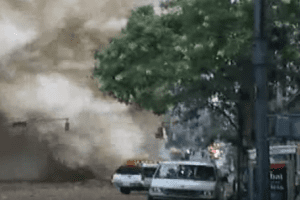
Steam Pipe Explosion Left A Huge Hole In The Street. A steam pipe used by Con Edison in New York City violently exploded on July 18, 2007, injuring more than 30 people, and leaving one dead. The force of the explosion left a huge hole in the street and sent a giant plume of 200-degree steam […]

Steam Pipe Explosion Left A Huge Hole In The Street. A steam pipe used by Con Edison in New York City violently exploded on July 18, 2007, injuring more than 30 people, and leaving one dead. The force of the explosion left a huge hole in the street and sent a giant plume of 200-degree steam and debris hundreds of feet into the air.
The blast occurred at 5:47 p.m. at East 41st and Lexington Avenue. Mayor Michael Bloomberg promptly announced that New York City was not under terrorist attack, saying instead that an aging steam pipe had exploded underground. The Mayor characterized the blast as a “failure of our infrastructure”.
The pipe, which was installed in the NYC street in 1924, could have exploded as a result of cold water collecting around it. The 24-inch pipe was part of a network used by the Con Edison Steam Business Unit to provide heat to 1,800 buildings in Manhattan.
New York City had been having heavy rain prior to the pipe explosion, and if cold water collected around the pipe, it could have created a “vapor condition”, causing the steam inside to condense. Eventually the pressure inside the pipe would have caused an explosion. Con Edison said that the pipe involved in this incident had been inspected six weeks ago.
On July 19, the New York City Office of Emergency Management (OEM) announced that debris from the pipe explosion had tested positive for the presence of asbestos. Long-term exposure to asbestos can lead to respiratory ailments like lung cancer and Mesothelioma, a rare cancer of the lungs almost always linked to asbestos exposure.
In 1989, the Environmental Protection Agency (EPA) banned most uses of asbestos, but it is still found as insulation in older pipes and buildings. The steam pipe involved in yesterday’s explosion was 84 years old.
While no asbestos was found in tests of air taken around the blast site, the OEM still urged people to take precautions. The city enforced a “frozen zone” between 40th Street and 43rd Street, and between Vanderbilt and Third Avenues.
While people already in the frozen were permitted to stay, no was be allowed to enter the area while clean up took place. The OEM cautioned anyone who was near the explosion to take precautions, including showering with soap and water, and placing any clothing they wore at the time in a plastic bag for cleaning or disposal.
People inside the frozen zone were told to keep windows shut, and set their air conditioners to a setting that would not bring in outside air.
The personal injury attorneys at Parker Waichman LLP offer free, no-obligation case evaluations. For more information, fill out our online contact form or call 1-800-YOURLAWYER (1-800-968-7529).


